泰姬陵英文介绍旅游英语
- 格式:ppt
- 大小:1.35 MB
- 文档页数:11
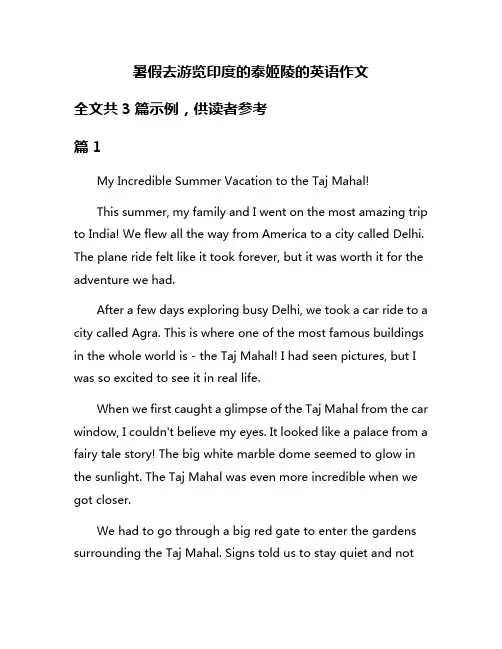
暑假去游览印度的泰姬陵的英语作文全文共3篇示例,供读者参考篇1My Incredible Summer Vacation to the Taj Mahal!This summer, my family and I went on the most amazing trip to India! We flew all the way from America to a city called Delhi. The plane ride felt like it took forever, but it was worth it for the adventure we had.After a few days exploring busy Delhi, we took a car ride to a city called Agra. This is where one of the most famous buildings in the whole world is - the Taj Mahal! I had seen pictures, but I was so excited to see it in real life.When we first caught a glimpse of the Taj Mahal from the car window, I couldn't believe my eyes. It looked like a palace from a fairy tale story! The big white marble dome seemed to glow in the sunlight. The Taj Mahal was even more incredible when we got closer.We had to go through a big red gate to enter the gardens surrounding the Taj Mahal. Signs told us to stay quiet and notmake any loud noises inside. I could understand why - this place was so peaceful and beautiful. It almost felt magical.The gardens had lots of trees, flowers, and fountains with geometric marble paths winding through them. In the distance, stood the breathtaking Taj Mahal itself at the end of a long rectangular pool. The whole scene looked like a perfect picture.As we walked closer, I could see all the intricate carvings and details on the Taj Mahal up close. Our guide told us it was built a long time ago in the 1600s by a Mughal emperor named Shah Jahan for his wife Mumtaz Mahal. It was meant to be a monument to their eternal love.I was amazed that people back then could build something so magnificent! The white marble seemed to change colors a little as the sun moved across the sky. Sometimes it looked pure white, then a little yellow, orange or even pink!We went inside through the main entrance and I was struck by how cool and quiet it felt compared to the hot day outside. The walls had precious stones like jade and crystals inlaid into them in beautiful designs of flowers and vines.At the center was the tomb itself - an elaborate octagonal chamber with a gorgeous lattice screen carved out of marblesurrounding it. This is where the emperor and his wife are buried in a simple crypt below. I felt like I was in a sacred place.After the main chamber, we went up narrow stairs to the top level and walked around the outside on the huge marble platform. From up there, we had an amazing view over the gardens and could appreciate the perfect symmetry of the whole Taj Mahal complex.I felt so small compared to this epic monument that people had spent over 20 years constructing by hand so long ago! No wonder it is one of the Seven Wonders of the Modern World. Seeing the Taj Mahal made me imagine what life was like back in the days of emperors and princes.After fully exploring the Taj Mahal, we had time to walk around the lively streets of Agra. We saw lopsided buildings crammed together, cows roaming around, shops selling bright colored fabric and spices, and lots of rickshaws and people everywhere. It felt like a totally different world from the calm, ordered Taj Mahal grounds.Visiting the Taj Mahal was the highlight of our whole India trip. It is one of the most astoundingly beautiful places I've ever seen. The perfect symmetry, the intricate marble work, the gardens, paintings and calligraphy...it was all breathtaking.I feel so lucky to have experienced the magnificent Taj Mahal in person at my age. It gave me a taste of India's incredible history and architecture. Spending a day surrounded by such an iconic labor of love and loss is something I'll never forget. This summer adventure was truly unforgettable!篇2My Summer Vacation Trip to the Taj MahalThis summer, my family and I went on the most amazing trip to India! We visited so many incredible places, but the Taj Mahal was definitely the most stunning. I had learned a little bit about the Taj Mahal in school, but seeing it in person was a million times better than any picture in a book.We arrived in Agra, the city where the Taj Mahal is located, after a very long flight from the United States. I was so tired from the journey, but as soon as I saw the Taj Mahal gleaming in the distance, I felt re-energized. "Look mom, look dad, there it is!" I shouted, pressing my face against the car window.As we got closer, I was in complete awe of how enormously big, bright, and beautiful it was. The Taj Mahal is made of white marble that seems to glow from within. The architect whodesigned it was definitely a genius! I couldn't wait to go inside and explore.When we finally made it through the entrance gates, I was stunned at the detailed craftsmanship up close. Every inch of the exterior walls is intricately carved with vines, flowers, and calligraphy. Our tour guide told us that the Taj Mahal was built in the 1600s by Emperor Shah Jahan as a mausoleum for his beloved wife Mumtaz Mahal. What a romantic gesture!The interior central dome was the first place we visited. I had to tilt my head all the way back to try to see the top of the massive dome ceiling. It felt like I was inside of a giant marble cave. Sunlight streamed in through the arched windows, making the precious stone inlaid decorations sparkle like a million diamonds. Simply breathtaking!Next, we wandered through the long halls and smaller side rooms surrounding the main mausoleum. Each room contained more incredibly detailed marble carvings, geometrically shaped doors, and colorful pietra dura (cut stone inlays) covering the floors, walls and ceilings. I couldn't imagine how many years it must have taken the artists and architects to construct this masterpiece. My favorite room had a wall with a carved marblelattice screen that perfectly framed the view of the main domed mausoleum. So beautiful!After exploring the interior, we headed outside to the meticulously landscaped gardens. Stretching out in front of the Taj Mahal are geometrically designed gardens divided by long marble pathways, fountains, and canals. Red blooming flowers and towering cypress trees provided pops of vibrant color surrounding the gleaming white marble. I could see why the Taj Mahal is considered one of the most elegant and romantic landscapes in the world.In the gardens behind the main mausoleum, we visited the twin mosque buildings made of the same white marble and intricate carvings as the Taj. Our guide explained they were used for prayers and services. I didn't realize mosques could be so incredibly gorgeous!Before we left, we made sure to get plenty of classic photos with the entire Taj Mahal in the background. I tried my best spirit fingers pose as we lined up in front of the iconic scene. I'm sure those will be cherished memories forever.Visiting the Taj Mahal was the most awe-inspiring experience I've ever had. Its grand size, immaculate marble beauty, and romantic meaning made it seem almost tooincredible to be real. I feel so lucky to have gotten the chance to witness this spectacular wonder of the world in person. India is a fascinating country with such a rich history and culture. I can't wait to go back someday and explore even more of the captivating sights and architecture. But for now, the vision of the majestic Taj Mahal will be seared into my mind forever as the absolute highlight of our summer vacation. What an unforgettable dream come true!篇3My Summer Vacation Trip to the Taj MahalThis summer, my family and I went on the most amazing trip to India! We visited lots of incredible places, but my absolute favorite was the Taj Mahal. The Taj Mahal is a beautiful marble mausoleum that was built in the 1600s by Emperor Shah Jahan as a monument to his beloved wife Mumtaz Mahal. It's considered one of the most stunning examples of Mughal architecture and is even one of the New Seven Wonders of the World!Our journey to see the Taj Mahal started very early one morning. We had to wake up before the sun came up so we could beat the crowds and the heat. We met our tour guide Raj who took us first to buy the entry tickets. Then we walkedthrough the West Gate and I couldn't believe my eyes when I first saw the Taj Mahal - it was even more breathtaking than in the pictures!The marble seemed to glow in the early morning light. The Taj Mahal complex is surrounded by beautiful gardens with trees, flowers, and fountains. Raj told us the gardens were designed to represent paradise as described in the Islamic holy book, the Quran. In the very center is the magnificent white marble Taj Mahal itself with its huge domed roof, tall minarets on each corner, and ornate calligraphy decorating the exterior.We spent hours exploring the Taj, walking around the outside to admire it from every angle. The front entrance has a massive archway with verses from the Quran inscribed at the top. We even got to go inside the mausoleum itself where the tombs of Shah Jahan and Mumtaz Mahal are located. The walls and ceilings are intricately carved with flowery designs andsemi-precious stones. It was dimly lit by sunlight filtering through the marble screens, making everything seem almost magical.After the Taj, we visited the mosque and museum on the West side of the complex. The mosque was built from red sandstone as a place of worship to complement the Taj Mahalmausoleum. In the museum, we saw miniature paintings, the Taj's original architectural plans, and Shah Jahan's jewelry and clothes. My favorite was probably his ruby-studded sword!Raj taught us so many interesting facts about the Taj Mahal's construction too. Did you know it took over 20 years and 20,000 workers from all across India and Asia to build? The white marble was brought all the way from quarries hundreds of miles away. And the huge dome on top is made of bricks, not marble, to keep it lightweight. The four minarets on the corners were designed to look perfectly symmetrical too even though they are slightly tilted outwards so they won't fall inwards in an earthquake. So clever!Seeing the Taj Mahal was the dreamiest experience. I loved learning about its history and all the work that went into creating such an exquisite labor of love. The details, symmetry, and beauty made it feel almost like a magic palace in a fairy tale. I'll never forget my first glimpse as we entered the East Gate and turned the corner to see the Taj in all its glory. Those few moments of awestruck silence before our group started snapping a million photos will be forever etched into my mind!After the Taj, we saw some other incredible sights in Agra like the Agra Fort and Baby Taj. We also got to do fun activities inother cities like riding an elephant, seeing snake charmers, and attending a Bollywood dance show. But the Taj Mahal was undoubtedly the crown jewel of our Indian adventure. I feel so lucky I got to see such an amazing wonder of the world before even finishing elementary school!I can't wait to go back to India again someday. There is still so much more I want to see and experience, like visiting the other mughals' tombs in Delhi or watching a cricket match. But no matter where I go, I know the Taj Mahal will always have a special place in my heart as my first truly jaw-dropping travel memory. Its magnificence and meaningful history behind it as a symbol of eternal love is just so powerful and unforgettable. I'm so grateful my parents gave me the chance to see it with my own eyes while I'm still a kid and be inspired to dream big. The Taj Mahal showed me that with enough hard work, vision, resources, and devotion, it's possible to create something stunningly beautiful that will be revered for generations to come. I only hope that someday I can channel that same passion and artistry into making my own meaningful contribution to the world.。

Taj MahalLocated at the city of Agra in the State of Uttar Pradesh, the Taj Mahal is one of the most beautiful masterpieces of architecture in the world. Agra, situated about 200 km south of New Delhi, was the Capital of the Mughals (Moguls), the Muslim Emperors who ruled Northern India between the sixteenth and nineteenth centuries. The Mughals were the descendents of two of the most skilled warriors in history: the Turks and the Mongols. The Mughal dynasty reached its highest strength and fame during the reign of their early Emperors, Akbar, Jehangir, and Shah Jehan.It was Shah Jehan who ordered the building of the Taj, in honor of his wife, Arjumand Banu who later became known as Mumtaz Mahal, the Distinguished of the Palace. Mumtaz and Shah Jehan were married in 1612 and, over the next 18 years, had 14 children together. The Empress used to accompany her husband in his military campaigns, and it was in 1630, in Burhanpur, that she gave birth to her last child, for she died in childbirth. So great was the Emperor love to his wife that he ordered the building of the most beautiful mausoleum on Earth for her.Although it is not known for sure who planned the Taj, the name of an Indian architect of Persian descent, Ustad Ahmad Lahori, has been cited in many sources. As soon as construction began in 1630, masons, craftsmen, sculptors, and calligraphers were summoned from Persia, the Ottoman Empire, and Europe to work on the masterpiece. The site was chosen near the Capital, Agra on the southwest bank of the River Yamuna. The architectural complex is comprised of five main elements: the Darwaza or main gateway, the Bageecha or garden, the Masjid or mosque, the Naqqar Khana or rest house, and the Rauza or the Taj Mahal mausoleum. The actual Tomb is situated inside the Taj.The unique mughal style combines elements of Persian, Central Asian, and Islamic architecture. Most impressive are the black and white chessboard marble floor, the four tall minarets (40 m high) at the corners of the structure, and the majestic dome in the middle. On closer look, the lettering of the Quran verses around the archways appears to be uniform, regardless of their height. The lettering spacing and density has been customized to give this impression to the beholder. Other illusionary effects have been accounted for in the geometry of the tomb and the tall minarets. The impressive pietra dura artwork includes geometric elements, plants and flowers, mostly common in Islamic architecture. The level of sophistication in artwork becomes obvious when one realizes that a 3 cm decorative element contains more than 50 inlaid gemstones.Although such a devotion to a wife reaching to build a monument seemed like a weakness for an emperor, Shah Jahan was clearly determined. He chose a peaceful site by the River of Jumna about one and a half miles away from Agra on the southern edge of the city, where could be seen from the Agra Fortress. The closeness to the river also met the water need for the construction and garden.Shah Jahan decided to move Mumtaz to Agra in December 1631 and was buried in a domed building temporarily on the construction site of the unique mausoleum in January 8, 1632.Mir Abul Karim and Mukamat Khan was positioned as supervisors of the construction, however the architect was never mentioned by the Mogul Empire‟s historians that left questions and disputes about the architect. Even though some insists that the building was the work of a European, the Venetian Geronimo Vereneo, there is no trace of European architectural style. Also Vereneo‟s tombstone in Agra, where the Christians were buried, it was stated that he died in Lahore but nothing more about the construction of Taj Mahal. The most reliable architect might be Ustad Ahmad Lahori, who was the architect of the Red Fort of Agra and most probably took part in the construction of Taj Mahal, which was indeed emphasised in a poem of his son Lutfullah Muhandis.The body of Mumtaz laid for the third and the finally at the center of the mausoleum on north-south with her face turned westward to Holy Mecca in May 26, 1633. Thethree-domed mosque was situated on the west with its alcove namely mihrab pointing the direction of Mecca for the prayers. The mosque on the east side might not used as a mosque in purpose but a pilgrimage guesthouse as the back wall was not marking Mecca. It might most probably build for the symmetry or echoing.The place was important for the pilgrims as Mumtaz died in childbirth who was considered as martyr following Islamic traditions. The building is influenced mostly from central Asian and Persian architecture combined with Muslim architecture. The construction was finished in twenty-two years with the power of twenty-thousand workers. Also the intricate stone carving usage, the domed kiosk namely chattri, are the traces of Hindu architecture. The characteristic Mogul octagonal design with eight chambers representing the eight divisions of the Koran was used in Taj Mahal and was topped by a gigantic double dome. The inner dome is about eighty feet from the ground. The gigantic outer dome rises like fruit or a flower bulb with its excellent proportion and is surrounded by four domed kiosks.The platform with 970 feet length and 364 feet width raising the mausoleum from the ground is surrounded by three storey four minarets on the corners with 139 feet height and completed with octagonal chattris. The building was made with mathematicalcalculations leaving no space for a fault in symmetry and balance. Brick, red sandstone and white marble were commonly used as the three main materials and finished with polished plaster on the surface. The constructions started in January 1632 with approximately five thousand labourers both local and from the other places of the empire with the marble platform.The huge white marbles were carried from Makrana on southwest of Jaipur (Amber) about four hundred kilometres away; stone cutters and carts were also rented as the order of Empire to be paid by the Empire Treasure. The marbles were cut flawlessly without any crack. In fact the mausoleum was not of pure marble but of bricks faced with marble. The bricks were made nearby the construction area, therefore, eliminating the transportation problem. Although it is not certain, the brick scaffolding might have been used rather than bamboo or the wood, if the weight and the worth of the materials were considered. The three feet above the ground was faced with marble, continued then with marble like plastered bricks in the interior parts of the mausoleum.Because the use of images of human or animal is strictly prohibited in Islamic traditions due to the belief of equalising the images with God, Islamic calligraphic designs, mostly writings of Koran, were commonly used inside and outside of the pure white building as the very important art of ornamentation. The talented Persian Abd-ul-Haqq with the title of “Amanat Khan” was positioned in Taj Mahal‟s calligraphic decoration who was before appointed by Jahangir on Akbar‟s tomb. He was also reputed to be the only one who was allowed to sign his works in Taj Mahal.His dated signatures give clues about the building duration and also reveal that the calligraphic works were started from up to down in utmost artistry. While the calligraphic work of the mausoleum was nearly completed by the end of 1637, Amanat was promoted and rewarded honourably by Shah Jahan with more salary and an elephant. According to the unsigned work on the gateway dated 1637 unfolds the magnificent inscriptions on the tomb was however must have been finished by another as Amanat Khan died around 1647-1648 after his last signature on the north front of the great gate with the inscription “Finished with His help, the Most High, *1057”(*lunar calendar). Also, the stone carvings and especially in mosque and guesthouse the floral themes as the sign of paradise are also considerably used in Taj Mahal as the main ornamentation types together with more than forty different types of gems came from various countries. Also some caravanserais were also built for the merchants and carriers around the construction area in order to meet their needs.The paradise resembling spectacular Tomb finished in 1643 while the every part of the complex had not been completed until 1653. The night of the 6th February 1643, was the first ceremony of the mourners of Mumtaz Mahal泰姬陵简介3Taj Mahal is regarded as one of the eight wonders of the world, and some Western historians have noted that its architectural beauty has never been surpassed. The Taj is the most beautiful monument built by the Mughals, the Muslim rulers of India. T aj Mahal is built entirely of white marble. Its stunning architectural beauty is beyond adequate description, particularly at dawn and sunset. The Taj seems to glow in the light of the full moon. On a foggy morning, the visitors experience the Taj as if suspended when viewed from across the Jamuna river.Taj Mahal was built by a Muslim, Emperor Shah Jahan (died 1666 C.E.) in the memory of his dear wife and queen Mumtaz Mahal at Agra, India. It is an "elegy in marble" or some say an expression of a "dream." Taj Mahal (meaning Crown Palace) is a Mausoleum that houses the grave of queen Mumtaz Mahal at the lower chamber. The grave of Shah Jahan was added to it later. The queen‟s real name was Arjumand Banu. In the tradition of the Mughals, important ladies of the royal family were given another name at their marriage or at some other significant event in their lives, and that new name was commonly used by the public. Shah Jahan's real name was Shahab-ud-din, and he was known as Prince Khurram before ascending to the throne in 1628.Taj Mahal was constructed over a period of twenty-two years, employing twenty thousand workers. It was completed in 1648 C.E. at a cost of 32 Million Rupees. The construction documents show that its master architect was Ustad …Isa, the renowned Islamic architect of his time. The documents contain names of those employed and the inventory of construction materials and their origin. Expert craftsmen from Delhi, Qannauj, Lahore, and Multan were employed. In addition, many renowned Muslim craftsmen from Baghdad, Shiraz and Bukhara worked on many specialized tasks.The Taj stands on a raised, square platform (186 x 186 feet) with its four corners truncated, forming an unequal octagon. The architectural design uses the interlocking arabesque concept, in which each element stands on its own and perfectly integrates with the main structure. It uses the principles of self-replicating geometry and a symmetry of architectural elements.Its central dome is fifty-eight feet in diameter and rises to a height of 213 feet. It is flanked by four subsidiary domed chambers. The four graceful, slender minarets are 162.5 feet each. The entire mausoleum (inside as well as outside) is decorated with inlaid design of flowers and calligraphy using precious gems such as agate and jasper. The main archways, chiseled with passages from the Holy Qur‟an and the bold scroll work of flowery pattern, give a captivating charm to its beauty. The central domed chamber and four adjoining chambers include many walls and panels of Islamic decoration.The mausoleum is a part of a vast complex comprising of a main gateway, an elaborate garden, a mosque (to the left), a guest house (to the right), and several other palatial buildings. The Taj is at the farthest end of this complex, with the river Jamuna behind it. The large garden contains four reflecting pools dividing it at the center. Each of these four sections is further subdivided into four sections and then each into yet another four sections. Like the Taj, the garden elements serve like Arabesque, standing on their own and also constituting the whole.泰姬陵简介4Taj MahalLocated at the city of Agra in the State of Uttar Pradesh, the Taj Mahal is one of the most beautiful masterpieces of architecture in the world. Agra, situated about 200 km south of New Delhi, was the Capital of the Mughals (Moguls), the Muslim Emperors who ruled Northern India between the sixteenth and nineteenth centuries. The Mughals were the descendents of two of the most skilled warriors in history: the Turks and the Mongols. The Mughal dynasty reached its highest strength and fame during the reign of their early Emperors, Akbar, Jehangir, and Shah Jehan.It was Shah Jehan who ordered the building of the Taj, in honor of his wife, Arjumand Banu who later became known as Mumtaz Mahal, the Distinguished of the Palace. Mumtaz and Shah Jehan were married in 1612 and, over the next 18 years, had 14 children together. The Empress used to accompany her husband in his military campaigns, and it was in 1630, in Burhanpur, that she gave birth to her last child, for she died in childbirth. So great was the Emperor love to his wife that he ordered the building of the most beautiful mausoleum on Earth for her.Although it is not known for sure who planned the Taj, the name of an Indian architect of Persian descent, Ustad Ahmad Lahori, has been cited in many sources. As soon as construction began in 1630, masons, craftsmen, sculptors, and calligraphers were summoned from Persia, the Ottoman Empire, and Europe to work on the masterpiece. The site was chosen near the Capital, Agra on the southwest bank of the River Yamuna. The architectural complex is comprised of five main elements: the Darwaza or main gateway, the Bageecha or garden, the Masjid or mosque, the Naqqar Khana or rest house, and the Rauza or the Taj Mahal mausoleum. The actual Tomb is situated inside the Taj.The unique mughal style combines elements of Persian, Central Asian, and Islamic architecture. Most impressive are the black and white chessboard marble floor, the four tall minarets (40 m high) at the corners of the structure, and the majestic dome in themiddle. On closer look, the lettering of the Quran verses around the archways appears to be uniform, regardless of their height. The lettering spacing and density has been customized to give this impression to the beholder. Other illusionary effects have been accounted for in the geometry of the tomb and the tall minarets. The impressive pietra dura artwork includes geometric elements, plants and flowers, mostly common in Islamic architecture. The level of sophistication in artwork becomes obvious when one realizes that a 3 cm decorative element contains more than 50 inlaid gemstones.泰姬陵简介5The construction of this marble masterpiece is credited to the Mughal emperor Shah Jahan who erected this mausoleum in memory of his beloved wife,Arjumarid Bano Begum;popularly known as Mumtaz Mahal,who died in A.H. 1040 (A.D. 1630)。
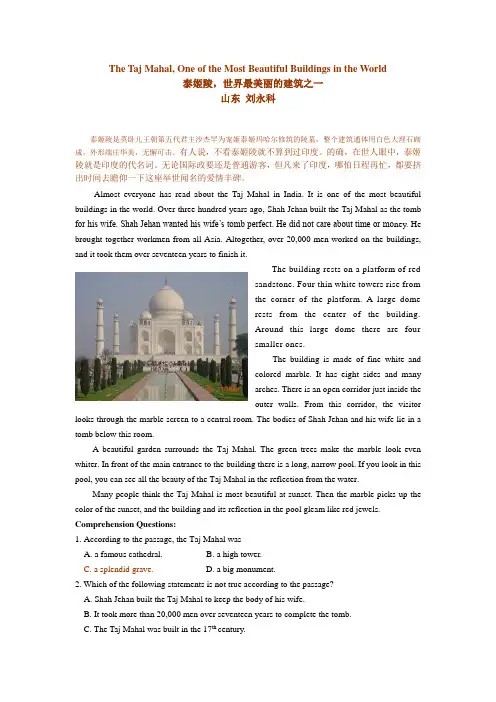
The Taj Mahal, One of the Most Beautiful Buildings in the W orld泰姬陵,世界最美丽的建筑之一山东刘永科泰姬陵是莫卧儿王朝第五代君主沙杰罕为宠姬泰姬玛哈尔修筑的陵墓,整个建筑通体用白色大理石砌成,外形端庄华美,无懈可击。
有人说,不看泰姬陵就不算到过印度。
的确,在世人眼中,泰姬陵就是印度的代名词。
无论国际政要还是普通游客,但凡来了印度,哪怕日程再忙,都要挤出时间去瞻仰一下这座举世闻名的爱情丰碑。
Almost everyone has read about the Taj Mahal in India. It is one of the most beautifulbuildings in the world. Over three hundred years ago, Shah Jehan built the Taj Mahal as the tombfor his wife. Shah Jehan wanted his wife’s tomb perfect. He did not care about time or mo ney. Hebrought together workmen from all Asia. Altogether, over 20,000 men worked on the buildings,and it took them over seventeen years to finish it.The building rests on a platform of redsandstone. Four thin white towers rise fromthe corner of the platform. A large domerests from the c enter of the building.Around this large dome there are foursmaller ones.The building is made of fine white andcolored marble. It has eight sides and manyarches. There is an open corridor just inside theouter walls. From this corridor, the visitorlooks through the marble screen to a central room. The bodies of Shah Jehan and his wife lie in atomb below this room.A beautiful garden surrounds the Taj Mahal. The green trees make the marble look evenwhiter. In front of the main entrance to the building there is a long, narrow pool. If you look in thispool, you can see all the beauty of the Taj Mahal in the reflection from the water.Many people think the Taj Mahal is most beautiful at sunset. Then the marble picks up thecolor of the sunset, and the building and its reflection in the pool gleam like red jewels.Comprehension Questions:1. According to the passage, the Taj Mahal was ______A. a famous cathedral.B. a high tower.C. a splendid grave.D. a big monument.2. Which of the following statements is not true according to the passage? ______A. Shah Jehan built the Taj Mahal to keep the body of his wife.B. It took more than 20,000 men over seventeen years to complete the tomb.C. The Taj Mahal was built in the 17th century.D. Only the body of Shah Jehan’s wife is kept in the tomb.3. The building is based on ______A. fine white and colored marble.B. a platform of red sandstone.C. four thin white towers.D. a large dome and many arches.4. According to the last paragraph, the long, narrow pool is most probably to _____ of the building.A. the westB. the eastC. the northD. the south(山东省潍坊第七中学刘永科)。
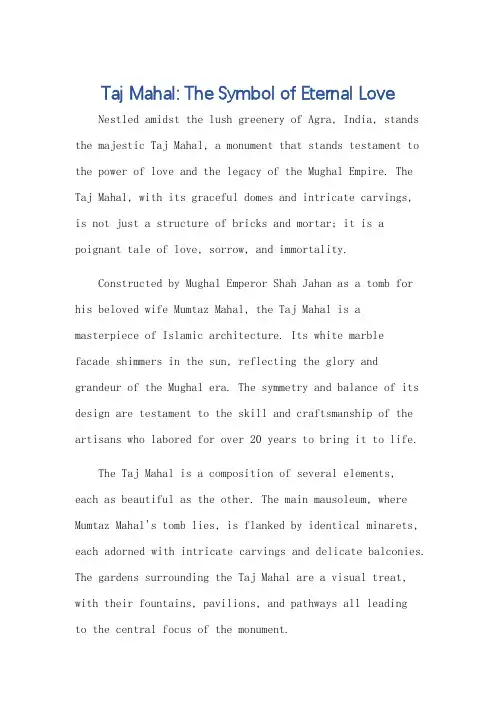
Taj Mahal: The Symbol of Eternal LoveNestled amidst the lush greenery of Agra, India, stands the majestic Taj Mahal, a monument that stands testament to the power of love and the legacy of the Mughal Empire. The Taj Mahal, with its graceful domes and intricate carvings,is not just a structure of bricks and mortar; it is a poignant tale of love, sorrow, and immortality.Constructed by Mughal Emperor Shah Jahan as a tomb for his beloved wife Mumtaz Mahal, the Taj Mahal is a masterpiece of Islamic architecture. Its white marblefacade shimmers in the sun, reflecting the glory and grandeur of the Mughal era. The symmetry and balance of its design are testament to the skill and craftsmanship of the artisans who labored for over 20 years to bring it to life. The Taj Mahal is a composition of several elements,each as beautiful as the other. The main mausoleum, where Mumtaz Mahal's tomb lies, is flanked by identical minarets, each adorned with intricate carvings and delicate balconies. The gardens surrounding the Taj Mahal are a visual treat, with their fountains, pavilions, and pathways all leadingto the central focus of the monument.What makes the Taj Mahal truly remarkable is not just its外在 beauty, but also its deeper symbolic meaning. It stands as a monument to the undying love of Shah Jahan for his wife. The emperor's love for Mumtaz Mahal was so profound that he wanted her tomb to be the most beautiful place in the world. His wish was fulfilled, and the Taj Mahal has become a symbol of eternal love and devotion.Over the centuries, the Taj Mahal has withstood thetest of time, weathering natural disasters and wars, yet retaining its majestic charm. It continues to draw millions of visitors from across the world, who come to admire its beauty and to be inspired by the story of love that lies within its walls.Today, the Taj Mahal is not just a tourist attraction; it is a national icon and a UNESCO World Heritage Site. It stands as a reminder of India's rich cultural heritage and the legacy of the Mughal Empire. As we stand before this magnificent monument, we are reminded of the power of love, the beauty of art, and the resilience of the human spirit. **泰姬陵:永恒之爱的象征**坐落在印度阿格拉郁郁葱葱的绿意之中,雄伟壮观的泰姬陵矗立于此,它不仅是爱情的见证,也是莫卧儿帝国遗产的象征。
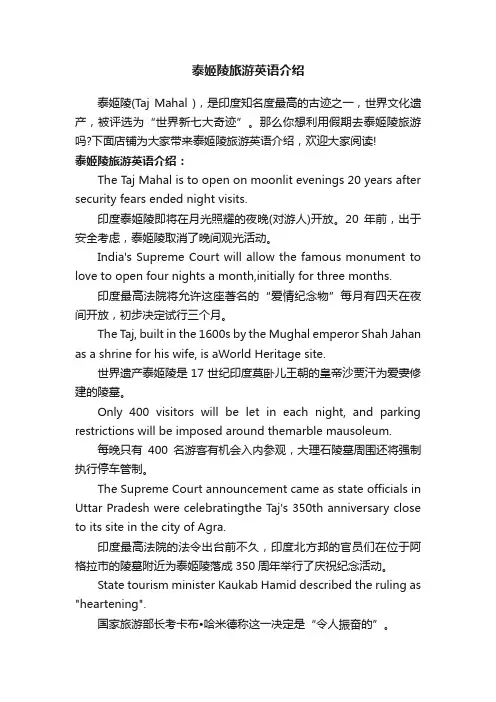
泰姬陵旅游英语介绍泰姬陵(Taj Mahal ),是印度知名度最高的古迹之一,世界文化遗产,被评选为“世界新七大奇迹”。
那么你想利用假期去泰姬陵旅游吗?下面店铺为大家带来泰姬陵旅游英语介绍,欢迎大家阅读!泰姬陵旅游英语介绍:The Taj Mahal is to open on moonlit evenings 20 years after security fears ended night visits.印度泰姬陵即将在月光照耀的夜晚(对游人)开放。
20年前,出于安全考虑,泰姬陵取消了晚间观光活动。
India's Supreme Court will allow the famous monument to love to open four nights a month,initially for three months.印度最高法院将允许这座著名的“爱情纪念物”每月有四天在夜间开放,初步决定试行三个月。
The Taj, built in the 1600s by the Mughal emperor Shah Jahan as a shrine for his wife, is aWorld Heritage site.世界遗产泰姬陵是17世纪印度莫卧儿王朝的皇帝沙贾汗为爱妻修建的陵墓。
Only 400 visitors will be let in each night, and parking restrictions will be imposed around themarble mausoleum.每晚只有400名游客有机会入内参观,大理石陵墓周围还将强制执行停车管制。
The Supreme Court announcement came as state officials in Uttar Pradesh were celebratingthe T aj's 350th anniversary close to its site in the city of Agra.印度最高法院的法令出台前不久,印度北方邦的官员们在位于阿格拉市的陵墓附近为泰姬陵落成350周年举行了庆祝纪念活动。

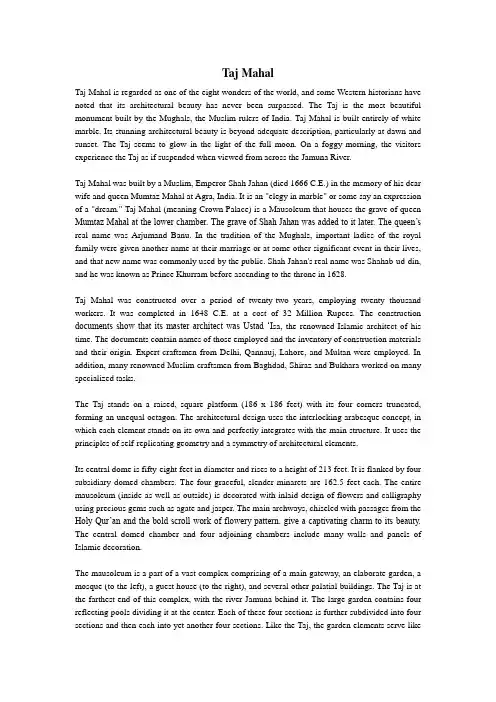
Taj MahalTaj Mahal is regarded as one of the eight wonders of the world, and some Western historians have noted that its architectural beauty has never been surpassed. The Taj is the most beautiful monument built by the Mughals, the Muslim rulers of India. Taj Mahal is built entirely of white marble. Its stunning architectural beauty is beyond adequate description, particularly at dawn and sunset. The Taj seems to glow in the light of the full moon. On a foggy morning, the visitors experience the Taj as if suspended when viewed from across the Jamuna River.Taj Mahal was built by a Muslim, Emperor Shah Jahan (died 1666 C.E.) in the memory of his dear wife and queen Mumtaz Mahal at Agra, India. It is an "elegy in marble" or some say an expression of a "dream." Taj Mahal (meaning Crown Palace) is a Mausoleum that houses the grave of queen Mumtaz Mahal at the lower chamber. The grave of Shah Jahan was added to it later. The queen’s real name was Arjumand Banu. In the tradition of the Mughals, important ladies of the royal family were given another name at their marriage or at some other significant event in their lives, and that new name was commonly used by the public. Shah Jahan's real name was Shahab-ud-din, and he was known as Prince Khurram before ascending to the throne in 1628.Taj Mahal was constructed over a period of twenty-two years, employing twenty thousand workers. It was completed in 1648 C.E. at a cost of 32 Million Rupees. The construction documents show that its master architect was Ustad ‘I sa, the renowned Islamic architect of his time. The documents contain names of those employed and the inventory of construction materials and their origin. Expert craftsmen from Delhi, Qannauj, Lahore, and Multan were employed. In addition, many renowned Muslim craftsmen from Baghdad, Shiraz and Bukhara worked on many specialized tasks.The Taj stands on a raised, square platform (186 x 186 feet) with its four corners truncated, forming an unequal octagon. The architectural design uses the interlocking arabesque concept, in which each element stands on its own and perfectly integrates with the main structure. It uses the principles of self-replicating geometry and a symmetry of architectural elements.Its central dome is fifty-eight feet in diameter and rises to a height of 213 feet. It is flanked by four subsidiary domed chambers. The four graceful, slender minarets are 162.5 feet each. The entire mausoleum (inside as well as outside) is decorated with inlaid design of flowers and calligraphy using precious gems such as agate and jasper. The main archways, chiseled with passages from the Holy Qur’an and the bold scroll work of flowery pattern, give a captivating charm to its beauty. The central domed chamber and four adjoining chambers include many walls and panels of Islamic decoration.The mausoleum is a part of a vast complex comprising of a main gateway, an elaborate garden, a mosque (to the left), a guest house (to the right), and several other palatial buildings. The Taj is at the farthest end of this complex, with the river Jamuna behind it. The large garden contains four reflecting pools dividing it at the center. Each of these four sections is further subdivided into four sections and then each into yet another four sections. Like the Taj, the garden elements serve likeArabesque, standing on their own and also constituting the whole.。
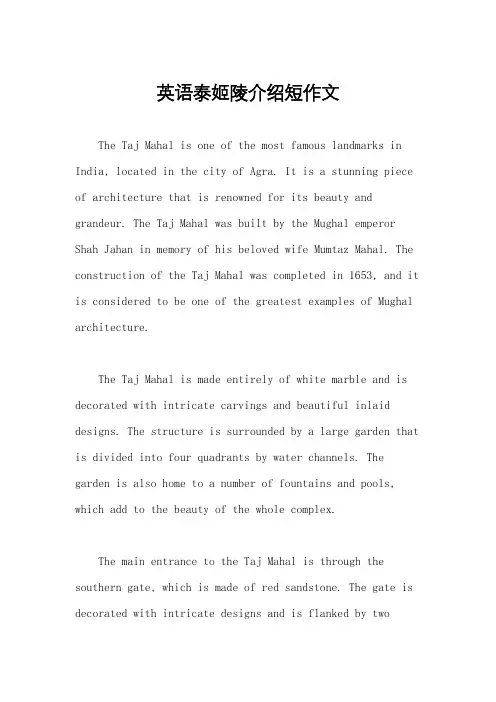
英语泰姬陵介绍短作文The Taj Mahal is one of the most famous landmarks in India, located in the city of Agra. It is a stunning piece of architecture that is renowned for its beauty and grandeur. The Taj Mahal was built by the Mughal emperor Shah Jahan in memory of his beloved wife Mumtaz Mahal. The construction of the Taj Mahal was completed in 1653, and it is considered to be one of the greatest examples of Mughal architecture.The Taj Mahal is made entirely of white marble and is decorated with intricate carvings and beautiful inlaid designs. The structure is surrounded by a large garden that is divided into four quadrants by water channels. The garden is also home to a number of fountains and pools, which add to the beauty of the whole complex.The main entrance to the Taj Mahal is through the southern gate, which is made of red sandstone. The gate is decorated with intricate designs and is flanked by twotowers. As you enter the gate, you are greeted by a beautiful view of the Taj Mahal, which stands majestically in the center of the garden.The Taj Mahal is a mausoleum that houses the tombs of Shah Jahan and his wife Mumtaz Mahal. The tombs are located in the main chamber, which is decorated with beautiful marble carvings and inlaid designs. The tombs themselves are made of white marble and are decorated with precious stones.The Taj Mahal is not only a beautiful piece of architecture, but it is also a symbol of love and devotion. Shah Jahan built the Taj Mahal in memory of his beloved wife Mumtaz Mahal, who died while giving birth to their14th child. The Taj Mahal is a testament to the love that Shah Jahan had for his wife, and it is a reminder of the power of love and devotion.In conclusion, the Taj Mahal is a stunning piece of architecture that is renowned for its beauty and grandeur. It is a symbol of love and devotion, and it is a testamentto the power of love. The Taj Mahal is a must-visit destination for anyone who is interested in history, architecture, and culture.。
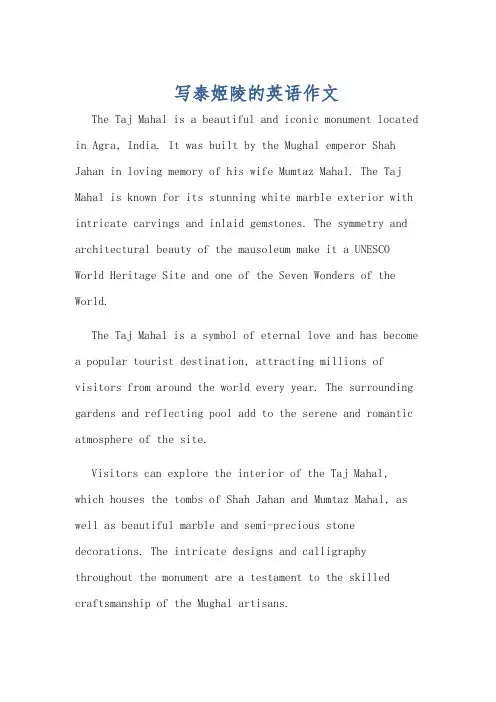
写泰姬陵的英语作文The Taj Mahal is a beautiful and iconic monument located in Agra, India. It was built by the Mughal emperor Shah Jahan in loving memory of his wife Mumtaz Mahal. The Taj Mahal is known for its stunning white marble exterior with intricate carvings and inlaid gemstones. The symmetry and architectural beauty of the mausoleum make it a UNESCO World Heritage Site and one of the Seven Wonders of the World.The Taj Mahal is a symbol of eternal love and has become a popular tourist destination, attracting millions of visitors from around the world every year. The surrounding gardens and reflecting pool add to the serene and romantic atmosphere of the site.Visitors can explore the interior of the Taj Mahal, which houses the tombs of Shah Jahan and Mumtaz Mahal, as well as beautiful marble and semi-precious stone decorations. The intricate designs and calligraphy throughout the monument are a testament to the skilled craftsmanship of the Mughal artisans.In addition to its historical and cultural significance, the Taj Mahal is also an architectural marvel. Itsperfectly symmetrical design and use of Persian and Mughal architectural styles make it a masterpiece of construction and engineering.Overall, the Taj Mahal is a must-visit destination for anyone interested in history, culture, and architecture.Its timeless beauty and profound symbolism continue to captivate people from all walks of life.泰姬陵是位于印度阿格拉的一座美丽而标志性的纪念碑。
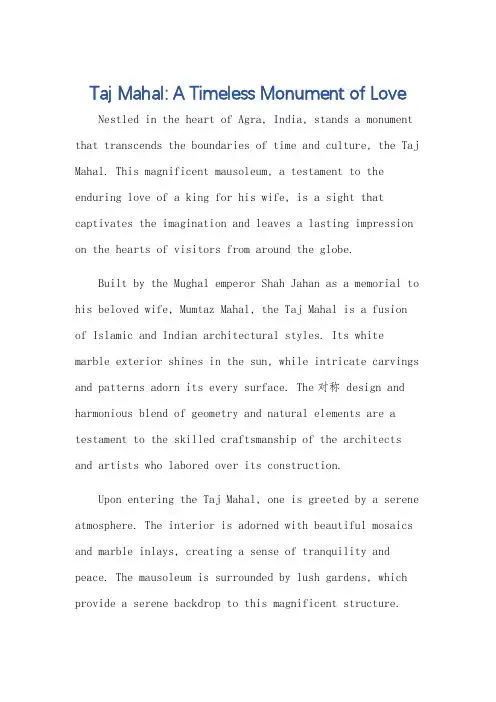
Taj Mahal: A Timeless Monument of Love Nestled in the heart of Agra, India, stands a monument that transcends the boundaries of time and culture, the Taj Mahal. This magnificent mausoleum, a testament to the enduring love of a king for his wife, is a sight that captivates the imagination and leaves a lasting impression on the hearts of visitors from around the globe.Built by the Mughal emperor Shah Jahan as a memorial to his beloved wife, Mumtaz Mahal, the Taj Mahal is a fusion of Islamic and Indian architectural styles. Its white marble exterior shines in the sun, while intricate carvings and patterns adorn its every surface. The对称 design and harmonious blend of geometry and natural elements are a testament to the skilled craftsmanship of the architects and artists who labored over its construction.Upon entering the Taj Mahal, one is greeted by a serene atmosphere. The interior is adorned with beautiful mosaics and marble inlays, creating a sense of tranquility and peace. The mausoleum is surrounded by lush gardens, which provide a serene backdrop to this magnificent structure.The Taj Mahal's legacy extends beyond its aesthetic appeal. It is a symbol of the rich cultural heritage of India, a testament to the union of different religions and cultures during the Mughal era. Its construction marked a period of unprecedented artistic and cultural flourishingin India, a time when the Mughal emperors patronized the arts and literature, leading to a vibrant exchange of ideas and influences.Today, the Taj Mahal stands as a symbol of India's rich history and cultural diversity. It attracts millions of visitors from around the world, who come to witness its beauty and understand the story of love and devotion that lies behind its construction. As the sun sets over the Taj Mahal, its white marble glows in the evening light, creating a magical and romantic atmosphere that leaves a lasting impression on the hearts of all who visit.**泰姬陵:永恒的爱情纪念碑**在印度阿格拉的心脏地带,矗立着一座跨越时空和文化的纪念碑,那就是泰姬陵。
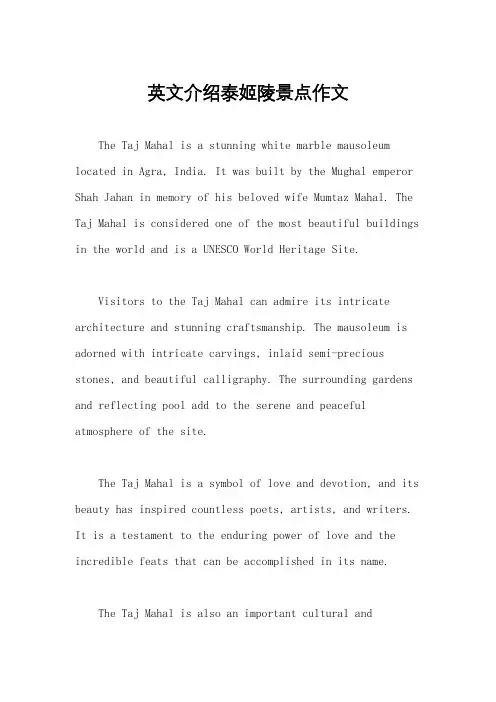
英文介绍泰姬陵景点作文The Taj Mahal is a stunning white marble mausoleum located in Agra, India. It was built by the Mughal emperor Shah Jahan in memory of his beloved wife Mumtaz Mahal. The Taj Mahal is considered one of the most beautiful buildings in the world and is a UNESCO World Heritage Site.Visitors to the Taj Mahal can admire its intricate architecture and stunning craftsmanship. The mausoleum is adorned with intricate carvings, inlaid semi-precious stones, and beautiful calligraphy. The surrounding gardens and reflecting pool add to the serene and peaceful atmosphere of the site.The Taj Mahal is a symbol of love and devotion, and its beauty has inspired countless poets, artists, and writers. It is a testament to the enduring power of love and the incredible feats that can be accomplished in its name.The Taj Mahal is also an important cultural andhistorical site in India. It attracts millions of visitors from around the world each year, who come to marvel at its beauty and learn about its fascinating history.In addition to its architectural and historical significance, the Taj Mahal is also a popular spot for photography enthusiasts. The changing light throughout the day creates stunning photo opportunities, and the mausoleum looks especially magical at sunrise and sunset.Overall, the Taj Mahal is a must-see destination for anyone visiting India. Its beauty, history, and cultural significance make it a truly unforgettable experience.。
英文介绍泰姬陵景点作文英文:Taj Mahal is one of the most famous tourist attractions in India. It is located in Agra, Uttar Pradesh, and was built by Mughal Emperor Shah Jahan in memory of his beloved wife Mumtaz Mahal. The construction of the Taj Mahal took over 20 years and involved over 20,000 workers.The Taj Mahal is a stunning piece of architecture, with its white marble exterior and intricate carvings. The main building has four minarets, each over 40 meters tall, and a central dome that stands over 70 meters high. The interior of the Taj Mahal is just as impressive, with beautiful marble floors, intricate designs, and precious stones.One of the most interesting things about the Taj Mahal is the way it changes color throughout the day. At sunrise, the white marble reflects the soft pink and orange hues of the sky. At midday, the Taj Mahal appears to be a brilliantwhite, while at sunset, it takes on a warm golden glow.Visiting the Taj Mahal is an unforgettable experience. The sheer size and beauty of the monument is awe-inspiring, and the history behind it is fascinating. It is also agreat place to take photos, as the Taj Mahal is one of the most photogenic buildings in the world.中文:泰姬陵是印度最著名的旅游景点之一。
暑假去游览印度的泰姬陵的英语作文(中英文实用版)During the summer vacation, I embarked on a fascinating journey to India, where I had the privilege to visit the renowned Taj Mahal.As I stood in awe before this architectural masterpiece, I was captivated by its serene beauty and the intricate details that adorned its walls.暑假期间,我踏上了一段令人神往的旅程,来到了印度,并有幸参观了著名的泰姬陵。
当我站在这座建筑杰作前,我为其宁静之美和墙壁上精致的细节所深深吸引。
The Taj Mahal, a UNESCO World Heritage Site, is a symbol of love, dedication, and architectural genius.Built by Emperor Shah Jahan in memory of his beloved wife, it stands as a testament to the power of love that transcends time and space.泰姬陵,作为联合国教科文组织的世界文化遗产,是爱情、奉献和建筑天才的象征。
它是沙贾汗皇帝为纪念心爱的妻子所建,成为了跨越时空的爱情力量的见证。
As I toured the Taj Mahal, I was struck by the perfect symmetry and the harmonious blend of different architectural styles.The white marble, inlaid with colorful gemstones, shimmered in the sunlight, creating an ethereal ambiance that left me in awe.在游览泰姬陵的过程中,我被其完美的对称性和不同建筑风格的和谐融合所打动。
The introduction of the taj mahalTaj Mahal is regarded as one of the eight wonders of the world, and some Western historians noted that its architectural beauty has never been beyond.泰姬陵被认为是世界的八大奇迹之一,和一些西方历史学家指出,其建筑美从未被超越The Taj is the most beautiful monument built by an Emperor Shah Jahan in the memory of his dear wife and queen Mumtaz Mahal at Agra, India.泰姬陵是最美丽的纪念碑建筑,由印度皇帝沙贾汗为了纪念他亲爱的妻子——泰姬女王而下令建造。
Taj Mahal is built entirely of white marble.Its stunning architectural beauty is beyond adequate description, particularly at dawn and sunset. The Taj seems to glow in the light of the full moon.泰姬陵是完全由白色大理石建成。
其惊人的建筑美是足够的描述之外,尤其是在黎明和日落。
泰姬陵似乎披上一层美丽的纱、Taj Mahal was constructed over a period of twenty-two years, employing twenty thousand workers. It was completed in 1648 at a cost of 32 Million Rupees(about3.2 million RMB)泰姬陵是二十二年的建造在一段时间内,雇佣二万名工人。
泰姬陵的英文作文英文:The Taj Mahal is a magnificent and stunning monument located in Agra, India. It was built by the Mughal emperor Shah Jahan in memory of his beloved wife Mumtaz Mahal. The Taj Mahal is considered one of the most beautiful buildings in the world and is a UNESCO World Heritage site.When I first laid eyes on the Taj Mahal, I was completely awestruck by its beauty and grandeur. The white marble structure with its intricate carvings and delicate inlay work left me speechless. The way the sunlight hits the marble and changes its color throughout the day istruly mesmerizing. It's no wonder that millions of tourists from all over the world visit the Taj Mahal every year.The love story behind the Taj Mahal adds to its allure. The emperor Shah Jahan was so heartbroken by the death of his wife that he commissioned the construction of the TajMahal as a symbol of his undying love for her. It's saidthat he wanted the Taj Mahal to be the most beautiful building in the world, and I think he definitely achieved that goal.Visiting the Taj Mahal was a surreal experience for me. Walking through the gardens and seeing the reflection ofthe monument in the pool was like stepping into a fairytale. The sheer size and symmetry of the Taj Mahal are breathtaking, and I found myself taking countless photos from every angle, trying to capture its beauty.中文:泰姬陵是一座位于印度阿格拉的宏伟壮丽的纪念碑。
The Taj Mahal is an ivory-white marble mausoleum located in Agra, India. It was commissioned by Mughal emperor Shah Jahan in memory of his favorite wife, Mumtaz Mahal, who died while giving birth to their 14th child in 1631. The construction of the Taj Mahal began in 1632 and was completed in 1653, taking over 20 years to build.The Taj Mahal is considered one of the greatest examples of Mughal architecture and a masterpiece of Indian art and culture. Its design is inspired by Persian, Islamic, and Indian architectural styles, and it features intricate carvings, beautiful gardens, and a large reflecting pool.The main building of the Taj Mahal is a symmetrical structure with a central dome and four minarets at each corner. The interior of the mausoleum is decorated with precious stones and marble inlaid with flowers and calligraphy. The tombs of Shah Jahan and Mumtaz Mahal are located on the lower level, while the upper level houses a mosque.Today, the Taj Mahal is one of the most popular tourist attractions in India, attracting millions of visitors every year. It is also recognized as a UNESCO World Heritage Site and was designated as a symbol of India's cultural heritage in 2004.。
写泰姬陵的英语作文Title: The Magnificence of the Taj MahalThe Taj Mahal, a mesmerizing masterpiece of architectural beauty, is an iconic symbol of India's rich cultural heritage. Situated in Agra, Uttar Pradesh, this magnificent white marble mausoleum was built by the Mughal Emperor Shah Jahan in memory of his beloved wife Mumtaz Mahal.The Taj Mahal is renowned for its intricate craftsmanship and symmetrical design. The elegant white marble facade is adorned with intricate carvings, delicate inlays of precious stones, and beautiful calligraphy from the Quran. The reflection pools and lush gardens surrounding the mausoleum further enhance its enchanting allure, creating a tranquil and visually stunning setting.Beyond its sheer beauty, the Taj Mahal holds profound historical and cultural significance. It represents the eternal love between Shah Jahan and Mumtaz Mahal, immortalized in this architectural marvel. The blending of Persian, Islamic, and Indian architectural styles in its design is a testament to the cultural synthesis that characterized the Mughal era.Visitors from around the world flock to witness the grandeur of the Taj Mahal and experience the serenity it exudes. As the first light of dawn illuminates its marble facade, casting a soft golden glow, or as the moonlight bathes it in a mystical sheen, the Taj Mahal never fails to captivate those who behold its splendor.In conclusion, the Taj Mahal stands as a testament to human creativity, craftsmanship, and enduring love. Its timeless beauty and cultural significance make it a treasure not only for India but for the world as a whole. A visit to the Taj Mahal is not just a journey to a historical site but a soulstirring experience that leaves an indelible mark on one's heart and mind.。